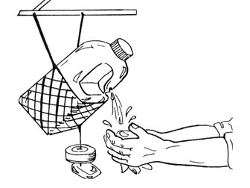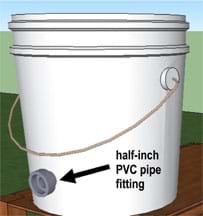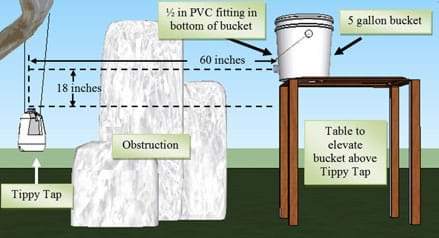Lesson: Tippy Tap Hand-Washer
 (Lesson courtesy TeachEngineering.org, Integrated Teaching and Learning Program, the University of Colorado, Boulder, College of Engineering)
(Lesson courtesy TeachEngineering.org, Integrated Teaching and Learning Program, the University of Colorado, Boulder, College of Engineering)
Grade Level: 10-12
Time: 3 hours (three class periods)
Summary
In this service-learning activity, student teams will learn the basic principles of fluid dynamics as well as how engineers improve society by designing a prototype system to pipe water from a storage tank to a simple hand-washing station called a Tippy Tap. These inexpensive, homemade devices are used extensively in the developing world, but because they must be manually refilled with water, they are of limited use in high-traffic areas.
Learning Objectives
After this activity, students should be able to:
- Calculate pressure, velocity, and elevation in a simple piping system.
- Apply Bernoulli’s equation to simple pipe systems.
- Perform simple estimates of head loss due to pipe fittings.
- Explain how to conserve energy in piping systems and what contributes to energy losses.
Standards
International Technology Education Association Standards
- K. A prototype is a working model used to test a design concept by making actual observations and necessary adjustments. [Grades 9 -12]
Common Core State Standards for Mathematics
1. Explain each step in solving a simple equation as following from the equality of numbers asserted at the previous step, starting from the assumption that the original equation has a solution. Construct a viable argument to justify a solution method. [Grades 9 – 12]
Prerequisite Knowledge
Students must have a basic knowledge of algebra, exponents, and how to use mathematical formulae. Prior exposure to the engineering design process is required. (Note: If students are unfamiliar with the design process, refer to http://www.teachengineering.org/engrdesignprocess.php or TeachEngineering’s Creative Engineering Design unit.)
Materials
Purchase the following items at any hardware or home improvement store (such as The Home Depot or Lowe’s). Total cost should run about $21.
Each group needs:
- Half-inch (inner diameter) PVC pipe, 5-ft (1.5m) length
- One-inch (inner diameter) PVC pipe, 5-ft (1.5 m) length
- 4 half-inch 90° PVC elbows
- 4 one-inch 90° PVC elbows
- 2 one-inch to half-inch PVC reducers
- miscellaneous PVC valves (butterfly, ball, globe, etc.)
- miscellaneous sizes of flexible (vinyl) tubing and barbed connectors
- duct tape
- Fluid Dynamics Basics Handout, one per person
- (optional) Brainstorming Guidelines
For the entire class to share:
- 1 Tippy Tap (or make one by following the attached Tippy Tap Construction instructions and these supplies: clean and empty one-gallon plastic milk jug, candle, matches, nail, pliers, plastic net, string or rope, metal support, knife, bar of soap, string, tin can lid)
- string or rope, 5 ft (1.5m) length
- five-gallon plastic bucket
- half-inch threaded PVC fitting
- drill and half-inch drill bit, to make a hole in the five-gallon bucket wall for the PVC fitting
- adhesive, to adhere the PVC fitting into the bucket wall
- water supply to fill a five-gallon bucket
- PVC pipe cutting tools, such as a saw or a 4-inch steel or PVC cutter.
- Towels or mop to clean up water spills (if conducting activity inside)
Introduction
Your local university’s Engineers Without Borders program has asked you to help on a sanitation project in Rwanda, Africa. The project aims to improve the health of children as young as 4, and as old as 20 who live in an orphanage in the community of Mugonero.
According to the World Health Organization, about 38 percent of the world lacks access to improved sanitation, which makes it unlikely that people wash their hands after bathroom use or before meals. Research has shown that washing hands with soap has been shown to reduce the risk of diarrheal disease by almost half. Thus, many people in underdeveloped countries suffer from diseases that could be prevented if they had a way to wash their hands regularly.
To this end, the Tippy Tap hand-washing station was developed and deployed in primarily rural communities in the developing world, such as Mugonero. The Tippy Tap (Figure 1 or the attached Tippy Tap Construction document) is a simple invention that enables hand washing without plumbing and with a fraction of the water used by a conventional/modern faucet with plumbing.
This device is made from a jug that releases a small amount of water when tipped. (See the Centers for Disease Control and Prevention construction and maintenance tip sheet.) Releasing the Tippy Tap causes it to swing back to its original position and stop the water flow. And, if a foot control is added, it becomes very hygienic because only the soap is touched.
Procedure

Fig. 2. Five-gallon bucket with a half-inch PVC fitting. Copyright © 2010 Benjamin S. Terry, ITL Program, College of Engineering, University of Colorado at Boulder
- Procure a Tippy Tap hand-washing station or build one using following the attached Tippy Top Construction instructions.
- Procure a five-gallon bucket to use as the water reservoir. Drill a hole in the side of the bucket at the bottom and use adhesive to attach a half-inch PVC fitting (see Figure 2).
- Gather materials and make copies of the Fluid Dynamics Basics Handout and (optional) Brainstorming Guidelines.
- Choose an appropriate location (outdoors is preferred) to test the piping systems created by the students.
- Set up the test area according to Figure 3.
- Suspend the Tippy Tap from a piece of playground equipment, a tree, etc. Note that the PVC fitting on the five-gallon bucket is 18 inches (46 cm) higher than the fill cap on the Tippy Tap and that the horizontal distance between the two is 60 inches (152 cm). Height above the ground is not critical, so choose a convenient height.
- Place an obstruction (as shown in Figure 3; can be anything, such as a large cardboard box) to ensure that students must use elbow style fittings or some other method to route the piping system in a non-direct path to the Tippy Tap.
With the Students – Day 1 (50 minutes)
- Explain the project motivation and show students the Tippy Tap and how it operates. (10 minutes) As time permits, ask students the pre-activity discussion questions described in the Assessment section.
- Explain the project objective — to provide an efficient conduit for water from the reservoir to the Tippy Tap. Lay out the requirements and constraints. (10 minutes) The conduit must:
- Fill the Tippy Tap quickly (teams compete based on time to fill)
- Not hinder the function of the Tippy Tap (it still must tip!)
- Not waste/spill water
- Be easier to use than filling the Tippy Tap carrying water by hand
- Divide the class into groups of three or four students each. To engage students prior to learning about basic fluid dynamics, have teams brainstorm possible solutions. (12 minutes) If students are unfamiliar with brainstorming, give each team a copy of the attached Brainstorming Guidelines. (Note: If time permits, incorporate an extensive activity on the brainstorming process described in TE’s Brainstorm Possible Solutions activity.)
- Distribute the handouts to the students and discuss. (18 minutes) This handout is a self-contained tutorial on the fundamentals of fluid flow with 11 homework problems. First, lead an in-class discussion about the material discussed in the handout, and then assign the questions as homework.
With the Students – Day 2 (50 minutes)
- Review handout answers and discuss any questions the students may have. (25 minutes)
- Revise initial brainstorming solutions and sketch designs. (10 minutes)
- After teams produce sketches, distribute materials and have students start building their prototypes. As groups finish their first prototypes, assist them with testing. Instruct the students to all work together in order to test their designs. With no support structure to hold their systems during testing, a few students may need to hold the pipe while others open the flow to the system at the five-gallon bucket and operate their fill mechanisms to the Tippy Tap. (15 minutes)
With the Students – Day 3 (50 minutes)
- Give groups time for multiple rebuild/test cycles in accordance with the design process. Record their best fill times and post class results.
- Discuss results as a class (as described in the post-activity assessment activity in the Assessment section).
- Take appropriate precautions as students use saws or knives to cut PVC pipes.
- Watch that spilled water does not make the floors (or ground) slippery.
Open-ended design projects can be difficult for students because no clear path to one solution exists. Keep students on task, working towards a feasible design, watching that they do not get stuck wasting too much time brainstorming or building unrealistic designs.
Assessments:
Activity Embedded Assessment: The Fluid Dynamics Basics Handout is a self-contained tutorial on the fundamentals of fluid flow with 11 homework problems. First, lead an in-class discussion about the material discussed in the handout, then have students work through the content and instructions provided in the handout, and assign the questions as homework.
Post-Activity Assessment: Use the following suggested questions to lead a concluding discussion for this activity. Ask the students:
- Whose piping design filled the Tippy Tap the quickest? Why did it work so well?
- Were some designs easier to use with the Tippy Tap? Are some designs less prone to spilling water? What are the tradeoffs between the various designs? How would you combine the best features from each design? (Possible answers: Perhaps a design was easier and more intuitive to use, but filled the Tippy Tap slower. Engineers often have to optimize their design, which means they try to maximize one aspect of their design [such as ease of use], while minimizing another aspect [such as fill time]. Optimization requires tradeoffs between competing requirements.)
- Big picture question: Some regions of the developing world have ample supplies of salty ocean water, but no fresh water. Suppose an efficient method for desalination is developed. What are some of the challenges associated with transporting water from coastal regions inland? (Possible answer: Moving water from a coastal region inland entails an increase in elevation. Increased elevation is one cause of head loss.)
Homework As a homework assignment, have students answer the 11 questions in the Fluid Dynamics Basics Handout. Review their answers to gauge their understanding of the material.
It’s In Your Hands: see how easily two villagers make a Tippy Tap:
Additional Resources:
- Tippy Taps Construction (pdf)
- Brainstorming Guidelines (pdf)
- Brainstorming Guidelines (doc)
- Fluid Dynamics Basics Handout (pdf)
- Fluid Dynamics Basics Handout (doc)
- Fluid Dynamics Basics Handout Answers (pdf)
- Fluid Dynamics Basics Handout Answers (doc)
Other resources:
The Tippy Tap, a hand washing device with running water. [2:16] A Ugandan villager shows how to make a Tippy Tap in this YouTube video.
Tippy Tap technology and health facts from Tippytap.org
Contributors: Benjamin S. Terry, Kaisa Wallace-Moyer, Stephanie Rivale, Denise W. Carlson
© 2010 by Regents of the University of Colorado.
Filed under: Class Activities, Grades 9-12, Grades 9-12, Grades 9-12, Lesson Plans
Tags: Agricultural Engineering, Bernoulli, Class Activities, developing nation, energy conservation, Environmental Engineering, fluid dynamics, Grades 9-12, Lesson Plan, pipe systems, pipes, pressure, sanitation, service learning, velocity, Water









